 There have been many analyses of the economic effects of Brexit, both before the referendum and at various times since, including analyses of the effects of the deal negotiated by Theresa May’s government and the EU. But with the prospect of a no-deal Brexit on 31 October under the new Boris Johnson government, attention has turned to the effects of leaving the EU without a deal.
There have been many analyses of the economic effects of Brexit, both before the referendum and at various times since, including analyses of the effects of the deal negotiated by Theresa May’s government and the EU. But with the prospect of a no-deal Brexit on 31 October under the new Boris Johnson government, attention has turned to the effects of leaving the EU without a deal.
There have been two major analyses recently of the likely effects of a no-deal Brexit – one by the International Monetary Fund (IMF) and one by the Office for Budget Responsibility (OBR).
IMF analysis
The first was in April by the IMF as part of its 6-monthly World Economic Outlook. In Scenario Box 1.1. ‘A No-Deal Brexit’ on page 28 of Chapter 1, the IMF looked at two possible scenarios.
Scenario A assumes no border disruptions and a relatively small increase in UK sovereign and corporate spreads. Scenario B incorporates significant border disruptions that increase import costs for UK firms and households (and to a lesser extent for the European Union) and a more severe tightening in financial conditions.
 Under both scenarios, UK exports to the EU and UK imports from the EU revert to WTO rules. As a result, tariffs are imposed by mid-2020 or earlier. Non-tariff barriers rise at first but are gradually reduced over time. Most free-trade arrangements between the EU and other countries are initially unavailable to the UK (see the blog EU strikes major trade deals) but both scenarios assume that ‘new trade agreements are secured after two years, and on terms similar to those currently in place.’
Under both scenarios, UK exports to the EU and UK imports from the EU revert to WTO rules. As a result, tariffs are imposed by mid-2020 or earlier. Non-tariff barriers rise at first but are gradually reduced over time. Most free-trade arrangements between the EU and other countries are initially unavailable to the UK (see the blog EU strikes major trade deals) but both scenarios assume that ‘new trade agreements are secured after two years, and on terms similar to those currently in place.’
Both scenarios also assume a reduction in net immigration from the EU of 25 000 per year until 2030. Both assume a rise in corporate and government bond rates, reflecting greater uncertainty, with the effect being greater in Scenario B. Both assume a relaxing of monetary and fiscal policy in response to downward pressures on the economy.
The IMF analysis shows a negative impact on UK GDP, with the economy falling into recession in late 2019 and in 2020. This is the result of higher trade costs and reduced business investment caused by a poorer economic outlook and increased uncertainty. By 2021, even under Scenario A, GDP is approximately 3.5% lower than it would have been if the UK had left the EU with the negotiated deal. For the rest of the EU, GDP is around 0.5% lower, although the effect varies considerably from country to country.
The IMF analysis makes optimistic assumptions, such as the UK being able to negotiate new trade deals with non-EU countries to replace those lost by leaving. More pessimistic assumptions would lead to greater costs.
OBR analysis
Building on the analysis of the IMF, the Office for Budget Responsibility considered the effect of a no-deal Brexit on the public finances in its biennial Fiscal risks report, published on 17 July 2019. This argues that, under the relatively benign Scenario A assumptions of the IMF, the lower GDP would result in annual public-sector net borrowing (PSNB) rising. By 2021/22, if the UK had left with the deal negotiated with the EU, PSNB would have been around £18bn. A no-deal Brexit would push this up to around £51bn.
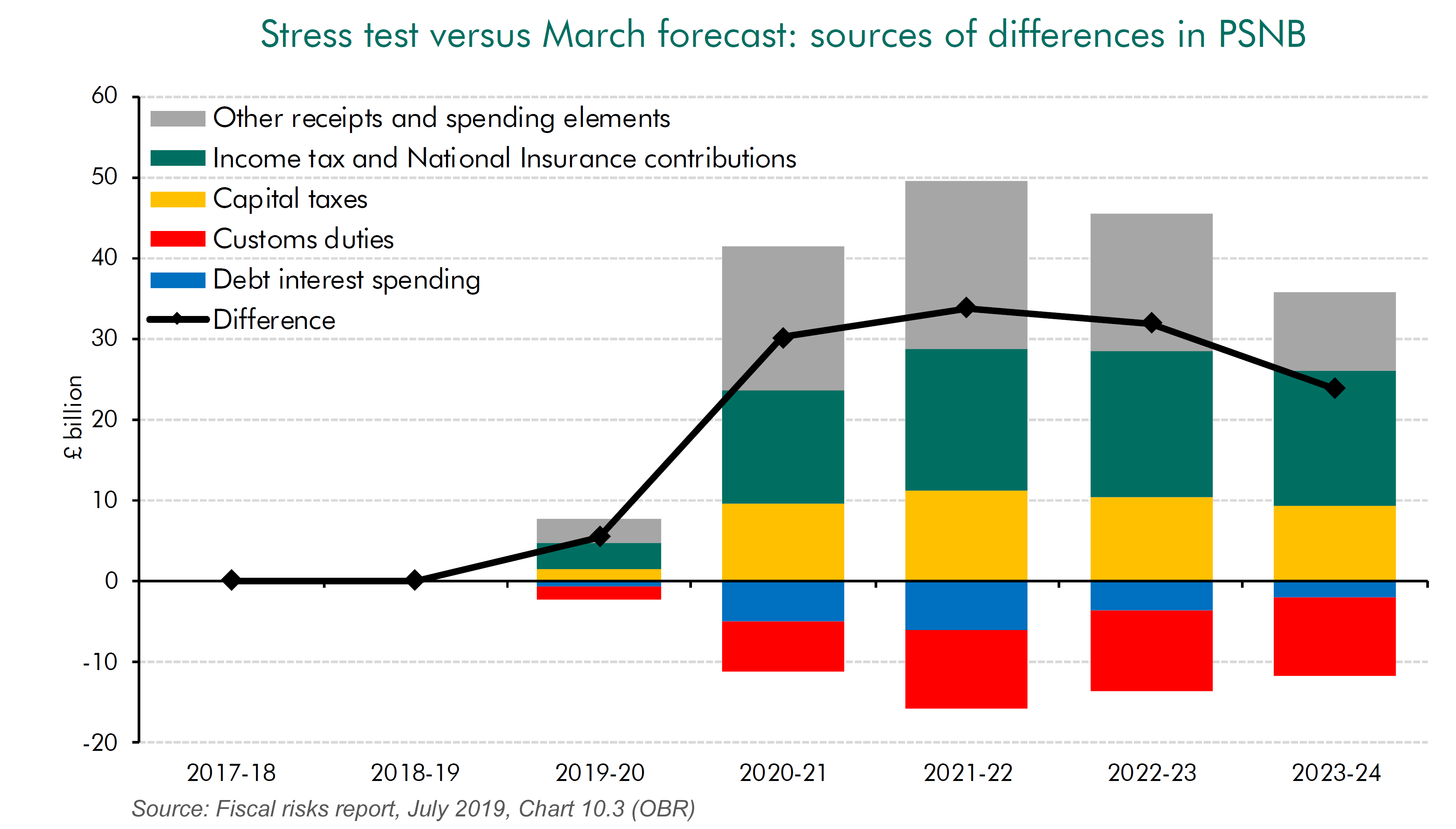
According to the OBR, the contributors to this rise in public-sector net borrowing of around £33bn are:
- A fall in income tax and national insurance receipts of around £16.5bn per year because of lower incomes.
- A fall in corporation tax and expenditure taxes, such as VAT, excise duties and stamp duty of around £22.5bn per year because of lower expenditure.
- A fall in capital taxes, such as inheritance tax and capital gains tax of around £10bn per year because of a fall in asset prices.
- These are offset to a small degree by a rise in customs duties (around £10bn) because of the imposition of tariffs and by lower debt repayments (of around £6bn) because of the Bank of England having to reduce interest rates.
The rise in PSNB would constrain the government’s ability to use fiscal policy to boost the economy and to engage in the large-scale capital projects advocated by Boris Johnson while making the substantial tax cuts he is proposing. A less optimistic set of assumptions would, of course, lead to a bigger rise in PSNB, which would further constrain fiscal policy.
Articles
Video
Reports
Questions
- What are the assumptions of the IMF World Economic Outlook forecasts for the effects of a no-deal Brexit? Do you agree with these assumptions? Explain.
- What are the assumptions of the analysis of a no-deal Brexit on the public finances in the OBR’s Fiscal risks report? Do you agree with these assumptions? Explain.
- What is the difference between forecasts and analyses of outcomes?
- For what reasons might growth over the next few years be higher than in the IMF forecasts under either scenario?
- For what reasons might growth over the next few years be lower than in the IMF forecasts under either scenario?
- For what reasons might public-sector net borrowing (PSNB) over the next few years be lower than in the OBR forecast?
- For what reasons might PSNB over the next few years be higher than in the OBR forecast?
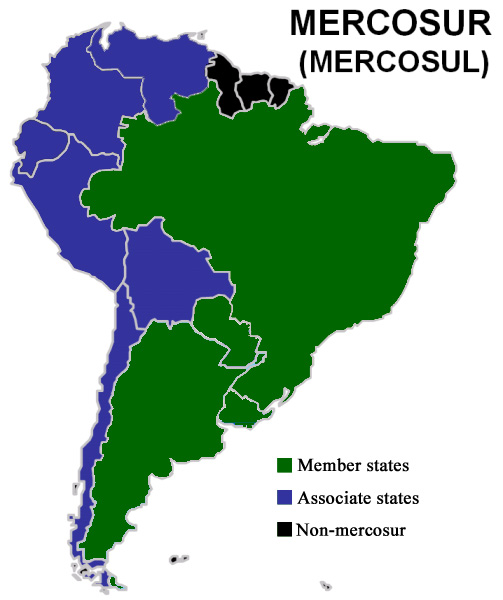 The EU has recently signed two trade deals after many years of negotiations. The first is with Mercosur, the South American trading and economic co-operation organisation, currently consisting of Brazil, Argentina, Uruguay and Paraguay – a region of over 260m people. The second is with Vietnam, which should result in tariff reductions of 99% of traded goods. This is the first deal of its kind with a developing country in Asia. These deals follow a recent landmark deal with Japan.
The EU has recently signed two trade deals after many years of negotiations. The first is with Mercosur, the South American trading and economic co-operation organisation, currently consisting of Brazil, Argentina, Uruguay and Paraguay – a region of over 260m people. The second is with Vietnam, which should result in tariff reductions of 99% of traded goods. This is the first deal of its kind with a developing country in Asia. These deals follow a recent landmark deal with Japan.
At a time when protectionism is on the rise, with the USA involved in trade disputes with a number of countries, such as China and the EU, deals to cut tariffs and other trade restrictions are seen as a positive development by those arguing that freer trade results in a net gain to the participants. The law of comparative advantage suggests that trade allows countries to consume beyond their production possibility curves. What is more, the competition experienced through increased trade can lead to greater efficiency and product development.
It is estimated that the deal with Mercosur could result in a saving of some €4bn per annum in tariffs on EU exports.
 But although there is a net economic gain from greater trade, some sectors will lose as consumers switch to cheaper imports. Thus the agricultural sector in many parts of the EU is worried about cheaper food imports from South America. What is more, increased trade could have detrimental environmental impacts. For example, greater imports of beef from Brazil into the EU could result in more Amazonian forest being cut down to graze cattle.
But although there is a net economic gain from greater trade, some sectors will lose as consumers switch to cheaper imports. Thus the agricultural sector in many parts of the EU is worried about cheaper food imports from South America. What is more, increased trade could have detrimental environmental impacts. For example, greater imports of beef from Brazil into the EU could result in more Amazonian forest being cut down to graze cattle.
But provided environmental externalities are internalised within trade deals and provided economies are given time to adjust to changing demand patterns, such large-scale trade deals can be of significant benefit to the participants. In the case of the EU–Mercosur agreement, according to the EU Reporter article, it:
…upholds the highest standards of food safety and consumer protection, as well as the precautionary principle for food safety and environmental rules and contains specific commitments on labour rights and environmental protection, including the implementation of the Paris climate agreement and related enforcement rules.
The size of the EU market and its economic power puts it in a strong position to get the best trade deals for its member states. As EU Trade Commissioner, Cecilia Malmström stated:
Over the past few years the EU has consolidated its position as the global leader in open and sustainable trade. Agreements with 15 countries have entered into force since 2014, notably with Canada and Japan. This agreement adds four more countries to our impressive roster of trade allies.
Outside the EU, the UK will have less power to negotiate similar deals.
Articles
Questions
- Draw a diagram to illustrate the gains for a previously closed economy from engaging in trade by specialising in products in which it has a comparative advantage.
- Distinguish between trade creation and trade diversion from a trade deal with another country or group of countries.
- Which sectors in the EU and which sectors in the Mercosur countries and Vietnam are likely to benefit the most from the respective trade deals?
- Which sectors in the EU and which sectors in the Mercosur countries and Vietnam are likely to lose from the respective trade deals?
- Are the EU–Mercosur and the EU–Vietnam trade deals likely to lead to net trade creation or net trade diversion?
- What are the potential environmental dangers from a trade deal between the EU and Mercosur? To what extent have these dangers been addressed in the recent draft agreement?
- Will the UK benefit from the EU’s trade deals with Mercosur and Vietnam?
 Consumer credit is borrowing by individuals to finance current expenditure on goods and services. Consumer credit is distinct from lending secured on dwellings (referred to more simply as ‘secured lending’). Consumer credit comprises lending on credit cards, lending through overdraft facilities and other loans and advances, for example those financing the purchase of cars. We consider here recent trends in the flows of consumer credit in the UK and discuss their implications.
Consumer credit is borrowing by individuals to finance current expenditure on goods and services. Consumer credit is distinct from lending secured on dwellings (referred to more simply as ‘secured lending’). Consumer credit comprises lending on credit cards, lending through overdraft facilities and other loans and advances, for example those financing the purchase of cars. We consider here recent trends in the flows of consumer credit in the UK and discuss their implications.
Analysing consumer credit data is important because the growth of consumer credit has implications for the financial wellbeing or financial health of individuals and, of course, for financial institutions. As we shall see shortly, the data on consumer credit is consistent with the existence of credit cycles. Cycles in consumer credit have the potential to be not only financially harmful but economically destabilising. After all, consumer credit is lending to finance spending and therefore the amount of lending can have significant effects on aggregate demand and economic activity.
Data on consumer credit are available monthly and so provide an early indication of movements in economic activity. Furthermore, because lending flows are likely to be sensitive to changes in the confidence of both borrowers and lenders, changes in the growth of consumer credit can indicate turning points in the economy and, hence, in the macroeconomic environment.
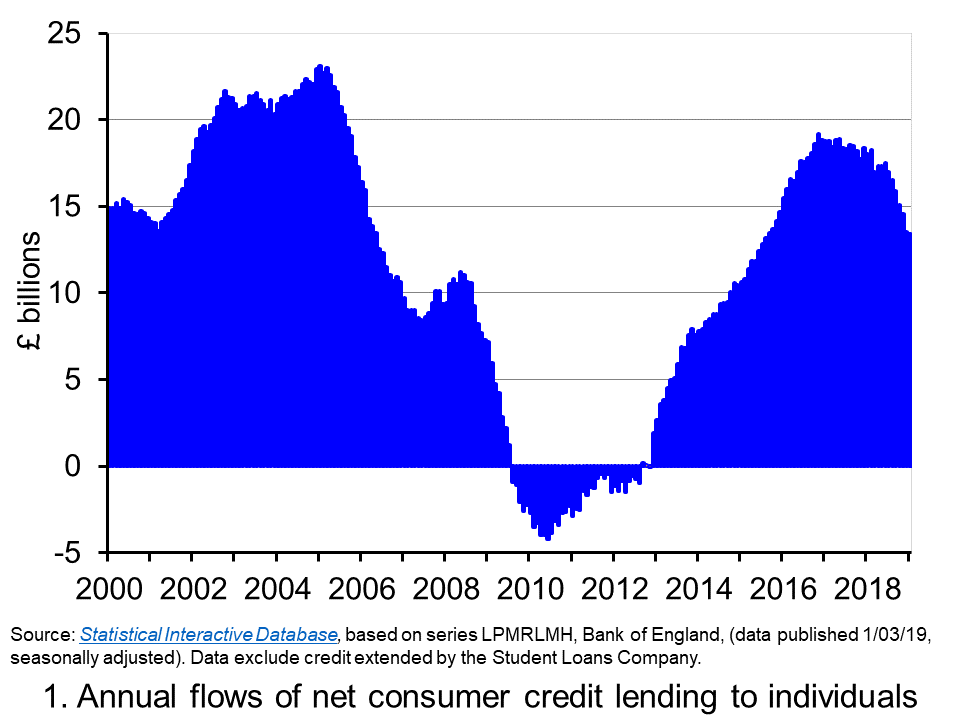 Chart 1 shows the annual flows of net consumer credit since 2000 – the figures are in £ billions. Net flows are gross flows less repayments. (Click here to download a PowerPoint copy of the chart.) In January 2005 the annual flow of net consumer credit peaked at £23 billion, the equivalent of just over 2.5 per cent of annual disposable income. This helped to fuel spending and by the final quarter of the year, the economy’s annual growth rate had reached 4.8 per cent, significantly about its long-run average of 2.5 per cent.
Chart 1 shows the annual flows of net consumer credit since 2000 – the figures are in £ billions. Net flows are gross flows less repayments. (Click here to download a PowerPoint copy of the chart.) In January 2005 the annual flow of net consumer credit peaked at £23 billion, the equivalent of just over 2.5 per cent of annual disposable income. This helped to fuel spending and by the final quarter of the year, the economy’s annual growth rate had reached 4.8 per cent, significantly about its long-run average of 2.5 per cent.
By 2009 net consumer credit flows had become negative. This meant that repayments were greater than additional flows of credit. It was not until 2012 that the annual flow of net consumer credit was again positive. Yet by November 2016, the annual flow of net consumer credit had rebounded to over £19 billion, the equivalent of just shy of 1.5 per cent of annual disposable income. This was the largest annual flow of consumer credit since September 2005.
Although the strength of consumer credit in 2016 was providing the economy with a timely boost to growth in the immediate aftermath of the referendum on the UK’s membership of the EU, it nonetheless raised concerns about its sustainability. Specifically, given the short amount of time that had elapsed since the financial crisis and the extreme levels of financial distress that had been experienced by many sectors of the economy, how susceptible would people and organisations be to a future economic slowdown and/or rise in interest rates?
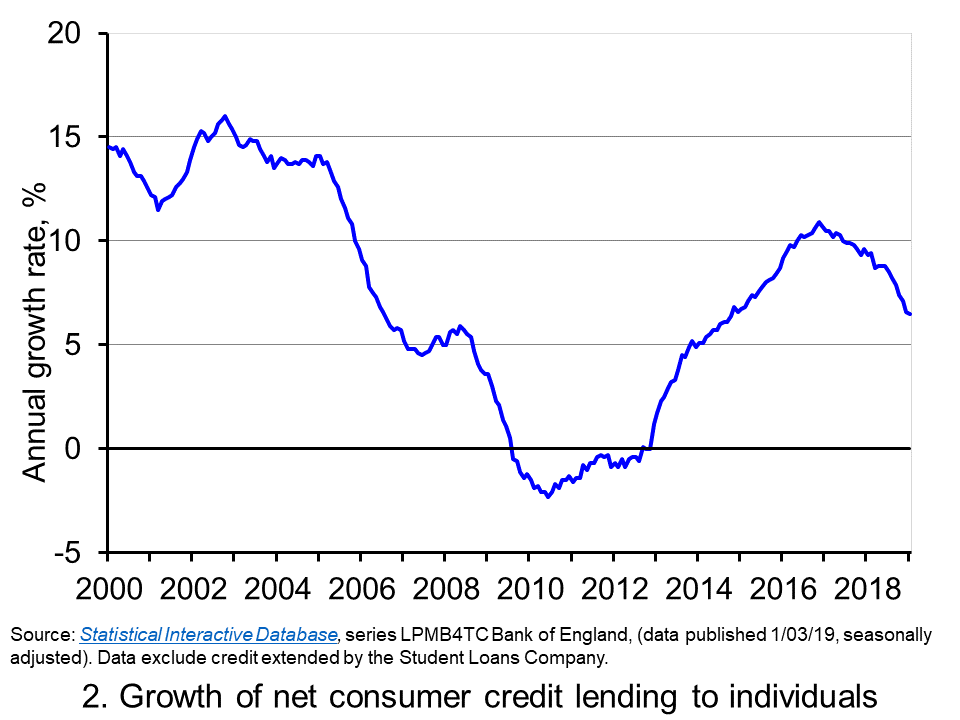 The extent to which the economy experiences consumer credit cycles can be seen even more readily by looking at the 12-month growth rate in the net consumer credit. In essence, this mirrors the growth rate in the stock of consumer credit. Chart 2 evidences the double-digit growth rates in net consumer credit lending experienced during the first half of the 2000s. Growth rates then eased but, as the financial crisis unfolded, they plunged sharply. (Click here to download a PowerPoint copy of the chart.)
The extent to which the economy experiences consumer credit cycles can be seen even more readily by looking at the 12-month growth rate in the net consumer credit. In essence, this mirrors the growth rate in the stock of consumer credit. Chart 2 evidences the double-digit growth rates in net consumer credit lending experienced during the first half of the 2000s. Growth rates then eased but, as the financial crisis unfolded, they plunged sharply. (Click here to download a PowerPoint copy of the chart.)
Yet, as Chart 2 shows, consumer credit growth began to recover quickly from 2013 so that by 2016 the annual growth rate of net consumer credit was again in double figures. In November 2016 the 12-month growth rate of net consumer credit peaked at 10.9 per cent. Thereafter, the growth rate has continually eased. In January 2019 the annual growth rate of net consumer credit had fallen back to 6.5 per cent, the lowest rate since October 2014.
The easing of consumer credit is likely to have been influenced, in part, by the resumption in the growth of real earnings from 2018 (see Getting real with pay). Yet, it is hard to look past the economic uncertainties around Brexit.
Uncertainty tends to cause people to be more cautious. With the heightened uncertainty that has has characterised recent times, it is likely that for many people and businesses prudence has dominated impatience. Therefore, in summary, it appears that prudence is helping to steer borrowing along a downswing in the credit cycle. As it does, it helps to put a further brake on spending and economic growth.
Articles
Questions
- What is the difference between gross and net lending?
- Consider the argument that we should be worried more by excessive growth in consumer credit than on lending secured on dwellings?
- How could we measure whether different sectors of the economy had become financially distressed?
- What might explain why an economy experiences credit cycles?
- Explain how the growth in net consumer credit can affect economic activity?
- If people are consumption smoothers, how can credit cycles arise?
- What are the potential policy implications of credit cycles?
- It is said that when making financial decisions people face an inter-temporal choice. Explain what you understand this by this concept.
- If economic uncertainty is perceived to have increased how could this affect the consumption, saving and borrowing decisions of people?

Late January sees the annual global World Economic Forum meeting of politicians, businesspeople and the great and the good at Davos in Switzerland. Global economic, political, social and environmental issues are discussed and, sometimes, agreements are reached between world leaders. The 2019 meeting was somewhat subdued as worries persist about a global slowdown, Brexit and the trade war between the USA and China. Donald Trump, Xi Jinping, Vladimir Putin and Theresa May were all absent, each having more pressing issues to attend to at home.
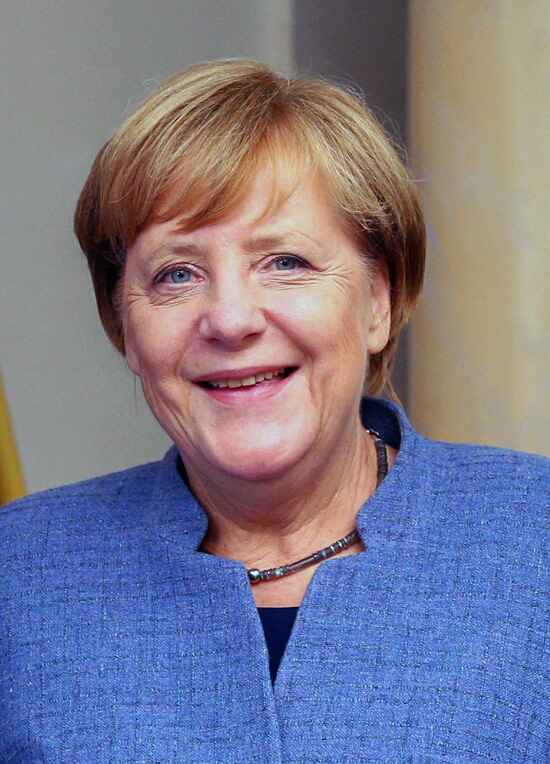 There was, however, a feeling that the world economic order is changing, with the rise in populism and with less certainty about the continuance of the model of freer trade and a model of capitalism modified by market intervention. There was also concern about the roles of the three major international institutions set up at the end of World War II: the IMF, the World Bank and the WTO (formerly the GATT). In a key speech, Angela Merkel urged countries not to abandon the world economic order that such institutions help to maintain. The world can only resolve disputes and promote development, she argued, by co-operating and respecting the role of such institutions.
There was, however, a feeling that the world economic order is changing, with the rise in populism and with less certainty about the continuance of the model of freer trade and a model of capitalism modified by market intervention. There was also concern about the roles of the three major international institutions set up at the end of World War II: the IMF, the World Bank and the WTO (formerly the GATT). In a key speech, Angela Merkel urged countries not to abandon the world economic order that such institutions help to maintain. The world can only resolve disputes and promote development, she argued, by co-operating and respecting the role of such institutions.
But the role of these institutions has been a topic of controversy for many years and their role has changed somewhat. Originally, the IMF’s role was to support an adjustable peg exchange rate system (the ‘Bretton Woods‘ system) with the US dollar as the international reserve currency. It would lend to countries in balance of payments deficit to allow them to maintain their rate pegged to the dollar unless it was perceived to be a fundamental deficit, in which case they were expected to devalue their currency. The system collapsed in 1971, but the IMF continued to provide short-term, and sometimes longer-term, finance to countries in balance of payments difficulties.
 The World Bank was primarily set up to provide development finance to poorer countries. The General Agreement on Tariffs and Trade (GATT) and then the WTO were set up to encourage freer trade and to resolve trade disputes.
The World Bank was primarily set up to provide development finance to poorer countries. The General Agreement on Tariffs and Trade (GATT) and then the WTO were set up to encourage freer trade and to resolve trade disputes.
However, the institutions were perceived with suspicion by many developing countries and by more left-leaning developed countries, who saw them as part of the ‘Washington consensus’. Loans from the IMF and World Bank were normally contingent on countries pursuing policies of market liberalisation, financial deregulation and privatisation.
Although there has been some movement, especially by the IMF, towards acknowledging market failures and supporting a more broadly-based development, there are still many economists and commentators calling for more radical reform of these institutions. They advocate that the World Bank and IMF should directly support investment – public as well as private – and support the Green New Deal.
Articles
Address
Questions
- What was the Bretton Woods system that was adopted at the end of World War II?
- What did Keynes propose as an alternative to the system that was actually adopted?
- Explain the roles of (a) the IMF, (b) the World Bank, (c) the WTO (formerly the GATT).
- What is meant by an adjustable exchange rate system?
- Why did the Bretton Woods system collapse in 1971?
- How have the roles of the IMF, World Bank and WTO/GATT evolved since they were founded?
- What reforms would you suggest to each of the three institutions and why?
- What threats are there currently to the international economic order?
- Summarise the arguments about the world economic order made by Angela Merkel in her address to the World Economic Forum.
 The Christmas and new year period often draws attention to the financial well-being of households. An important determinant of this is the extent of their indebtedness. Rising levels of debt mean that increasing amounts of households’ incomes becomes prey to servicing debt through repayments and interest charges. They can also result in more people becoming credit constrained, unable to access further credit. Rising debt levels can therefore lead to a deterioration of financial well-being and to financial distress. This was illustrated starkly by events at the end of the 2000s.
The Christmas and new year period often draws attention to the financial well-being of households. An important determinant of this is the extent of their indebtedness. Rising levels of debt mean that increasing amounts of households’ incomes becomes prey to servicing debt through repayments and interest charges. They can also result in more people becoming credit constrained, unable to access further credit. Rising debt levels can therefore lead to a deterioration of financial well-being and to financial distress. This was illustrated starkly by events at the end of the 2000s.
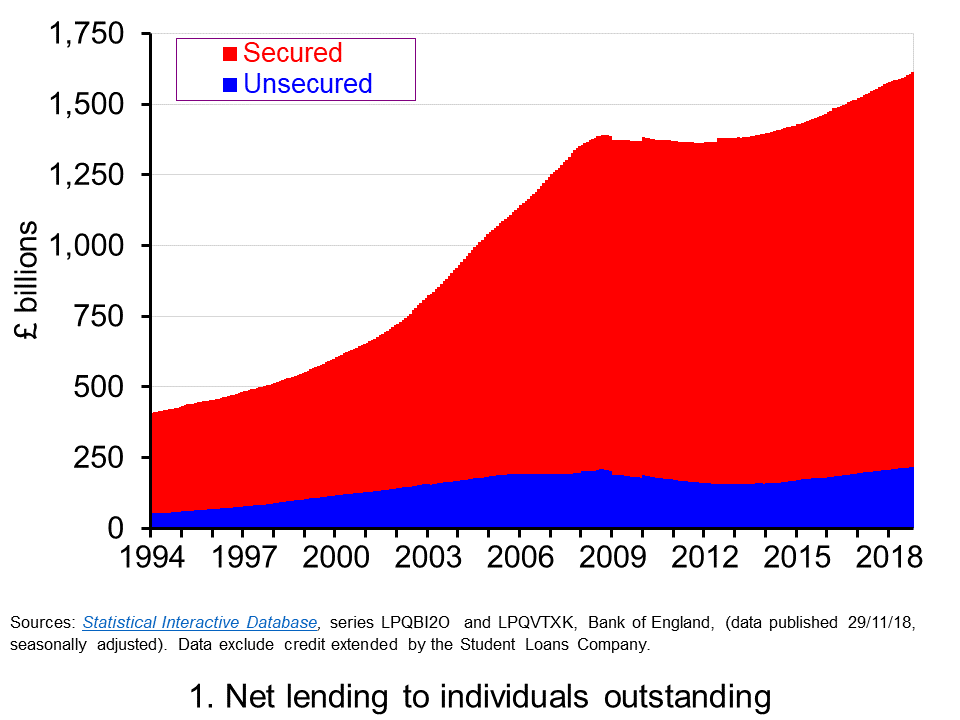 The total amount of lending by monetary financial institutions to individuals outstanding at the end of October 2018 was estimated at £1.61 trillion. As Chart 1 shows, this has grown from £408 billion in 1994. Hence, indivduals in the UK have experience a four-fold increase in the levels of debt. (Click here to download a PowerPoint of the chart.)
The total amount of lending by monetary financial institutions to individuals outstanding at the end of October 2018 was estimated at £1.61 trillion. As Chart 1 shows, this has grown from £408 billion in 1994. Hence, indivduals in the UK have experience a four-fold increase in the levels of debt. (Click here to download a PowerPoint of the chart.)
The debt of individuals is either secured or unsecured. Secured debt is debt secured by property, which for individuals is more commonly referred to as mortgage debt. Unsecured debt, which is also known as consumer credit, includes outstanding debt on credit cards, overdrafts on current accounts and loans for luxury items such as cars and electrical goods. The composition of debt in 2018 is unchanged from that in 1994: 87 per cent is secured debt and 13 per cent unsecured debt.
The fourfold increase in debt is taken by some economists as evidence of financialisation. While this term is frequently defined in distinctive ways depending upon the content in which it is applied, when viewed in very general terms it describes a process by which financial institutions and markets become increasingly important in everyday lives and so in the production and consumption choices that economists study. An implication of this is that in understanding economic decisions, behaviour and outcomes it becomes increasingly important to think about the potential impact of the financial system. The financial crisis is testimony to this.
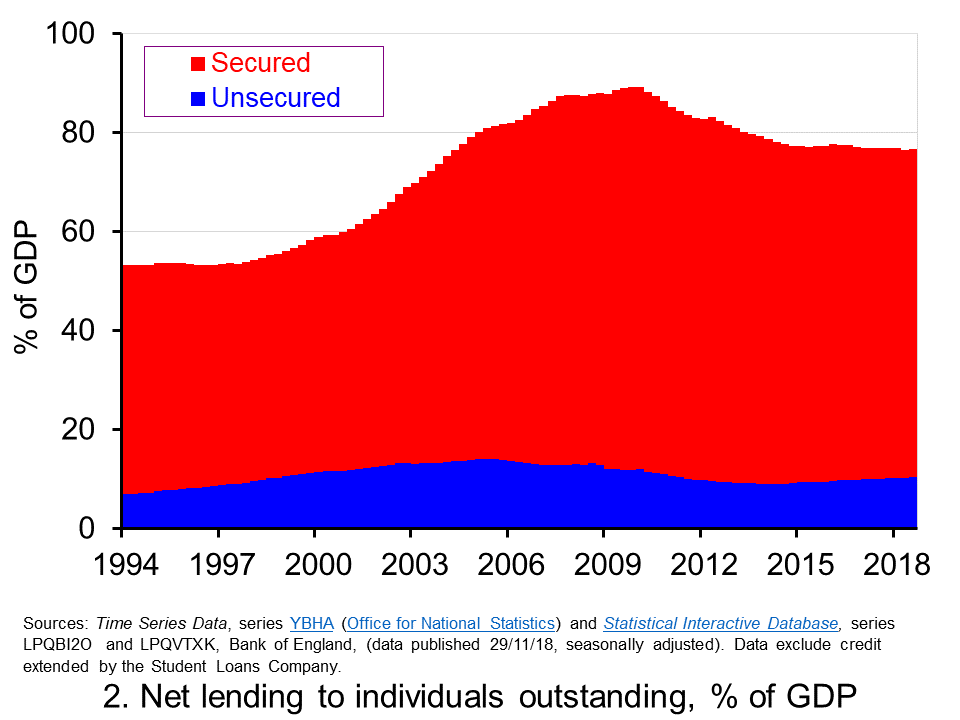 In thinking about financial well-being, at least at an aggregate level, we can look at the relative size of indebtedness. One way of doing this is to measure the stock of individual debt relative to the annual flow of GDP (national income). This is illustrated in Chart 2. (Click hereto download a PowerPoint of the chart.)
In thinking about financial well-being, at least at an aggregate level, we can look at the relative size of indebtedness. One way of doing this is to measure the stock of individual debt relative to the annual flow of GDP (national income). This is illustrated in Chart 2. (Click hereto download a PowerPoint of the chart.)
The growth in debt among individuals owed to financial institutions during the 2000s was significant. By the end of 2007, the debt-to-GDP ratio had reached 88 per cent. Decomposing this, the secured debt-to-GDP ratio had reached 75 per cent and the unsecured debt-to-GDP ratio 13 per cent. Compare this with the end of 1994 when secured debt was 46 per cent of GDP, unsecured debt 7 per cent and total debt 53 per cent. In other words, the period between 1994 and 2007 the UK saw a 25 percentage point increase in the debt-to-GDP ratio of individuals.
The early 2010s saw a consolidation in the size of the debt (see Chart 1) which meant that it was not until 2014 that debt levels rose above those of 2008. This led to the size of debt relative to GDP falling back by close to 10 percentage points (see Chart 2). Between 2014 and 2018 the stock of debt has increased from around £1.4 trillion to the current level of £1.61 trillion. This increase has been matched by a similar increase in (nominal) GDP so that the relative stock of debt remains little changed at present at around 76 per cent of GDP.
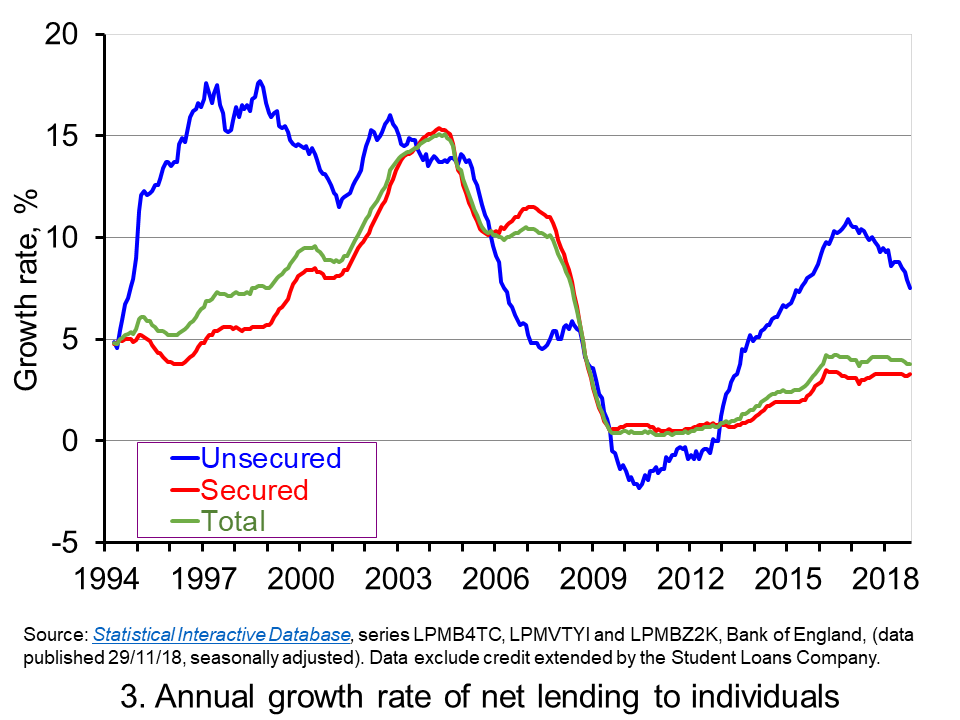 Chart 3 shows the annual growth rate of net lending (lending net of repayments) by monetary financial institutions to individuals. This essentially captures the growth rate in the stocks of debt, though changes in the actual stock of debt are also be affected by the writing-off of debts. (Click here to download a PowerPoint of the chart.)
Chart 3 shows the annual growth rate of net lending (lending net of repayments) by monetary financial institutions to individuals. This essentially captures the growth rate in the stocks of debt, though changes in the actual stock of debt are also be affected by the writing-off of debts. (Click here to download a PowerPoint of the chart.)
We can see quite readily the pick up in lending from 2014. The average annual rate of growth in total net lending since 2014 has been just a little under 3½ per cent. This has been driven by unsecured lending whose growth rate has been close to 8½ per cent per annum, compared to just 2.7 per cent for secured lending. In 2016 the annual growth rate of unsecured lending was just shy of 11 per cent. This helped to fuel concerns about possible future financial distress. These concerns remain despite the annual rate of growth in unsecured debt having eased slightly to 7.5 per cent.
Despite the aggregate debt-to-GDP ratio having been relatively stable of late, the recent growth in debt levels is clearly not without concern. It has to be viewed in the context of two important developments. First, there remains a ‘debt hangover’ from the financial distress experienced by the private sector at the end of the 2000s, which itself contributed to a significant decline in economic activity (real GDP fell by 4 per cent in 2009). This subequently affected the financial well-being of the public sector following its interventions to cushion the economy from the full effects of the economic downturn as well as to help stabilise the financial system. Second, there is considerable uncertainty surrounding the UK’s exit from the European Union.
The financial resilience of all sectors of the economy is therefore of acute concern given the unprecedented uncertainty we are currently facing while, at the same time, we are still feeling the effects of the financial distress from the financial crisis of the late 2000s. It therefore seems timely indeed for individuals to take stock of their stocks of debt.
Articles
Questions
- How might we measure the financial distress of individuals?
- If individuals are financially distressed how might this affect their consumption behaviour?
- How might credit constraints affect the relationship between consumption and income?
- What do you understand by the concept of ‘cash flow effects’ that arise from interest rate changes?
- How might the accumulation of secured and unsecured debt have different effects on consumer spending?
- What factors might explain the rate of accumulation of debt by individuals?
- What is meant by ‘financial resilience’ and why might this currently be of particular concern?
 There have been many analyses of the economic effects of Brexit, both before the referendum and at various times since, including analyses of the effects of the deal negotiated by Theresa May’s government and the EU. But with the prospect of a no-deal Brexit on 31 October under the new Boris Johnson government, attention has turned to the effects of leaving the EU without a deal.
There have been many analyses of the economic effects of Brexit, both before the referendum and at various times since, including analyses of the effects of the deal negotiated by Theresa May’s government and the EU. But with the prospect of a no-deal Brexit on 31 October under the new Boris Johnson government, attention has turned to the effects of leaving the EU without a deal. Under both scenarios, UK exports to the EU and UK imports from the EU revert to WTO rules. As a result, tariffs are imposed by mid-2020 or earlier. Non-tariff barriers rise at first but are gradually reduced over time. Most free-trade arrangements between the EU and other countries are initially unavailable to the UK (see the blog EU strikes major trade deals) but both scenarios assume that ‘new trade agreements are secured after two years, and on terms similar to those currently in place.’
Under both scenarios, UK exports to the EU and UK imports from the EU revert to WTO rules. As a result, tariffs are imposed by mid-2020 or earlier. Non-tariff barriers rise at first but are gradually reduced over time. Most free-trade arrangements between the EU and other countries are initially unavailable to the UK (see the blog EU strikes major trade deals) but both scenarios assume that ‘new trade agreements are secured after two years, and on terms similar to those currently in place.’
 No-deal Brexit would plunge UK into recession, OBR watchdog warns
No-deal Brexit would plunge UK into recession, OBR watchdog warns FT analysis of Brexit forecasts
FT analysis of Brexit forecasts OBR Fiscal risks report – live stream
OBR Fiscal risks report – live stream The EU has recently signed two trade deals after many years of negotiations. The first is with
The EU has recently signed two trade deals after many years of negotiations. The first is with  But although there is a net economic gain from greater trade, some sectors will lose as consumers switch to cheaper imports. Thus the agricultural sector in many parts of the EU is worried about cheaper food imports from South America. What is more, increased trade could have detrimental
But although there is a net economic gain from greater trade, some sectors will lose as consumers switch to cheaper imports. Thus the agricultural sector in many parts of the EU is worried about cheaper food imports from South America. What is more, increased trade could have detrimental  Consumer credit is borrowing by individuals to finance current expenditure on goods and services. Consumer credit is distinct from lending secured on dwellings (referred to more simply as ‘secured lending’). Consumer credit comprises lending on credit cards, lending through overdraft facilities and other loans and advances, for example those financing the purchase of cars. We consider here recent trends in the flows of consumer credit in the UK and discuss their implications.
Consumer credit is borrowing by individuals to finance current expenditure on goods and services. Consumer credit is distinct from lending secured on dwellings (referred to more simply as ‘secured lending’). Consumer credit comprises lending on credit cards, lending through overdraft facilities and other loans and advances, for example those financing the purchase of cars. We consider here recent trends in the flows of consumer credit in the UK and discuss their implications. Chart 1 shows the annual flows of net consumer credit since 2000 – the figures are in £ billions. Net flows are gross flows less repayments. (Click
Chart 1 shows the annual flows of net consumer credit since 2000 – the figures are in £ billions. Net flows are gross flows less repayments. (Click  The extent to which the economy experiences consumer credit cycles can be seen even more readily by looking at the 12-month growth rate in the net consumer credit. In essence, this mirrors the growth rate in the stock of consumer credit. Chart 2 evidences the double-digit growth rates in net consumer credit lending experienced during the first half of the 2000s. Growth rates then eased but, as the financial crisis unfolded, they plunged sharply. (Click
The extent to which the economy experiences consumer credit cycles can be seen even more readily by looking at the 12-month growth rate in the net consumer credit. In essence, this mirrors the growth rate in the stock of consumer credit. Chart 2 evidences the double-digit growth rates in net consumer credit lending experienced during the first half of the 2000s. Growth rates then eased but, as the financial crisis unfolded, they plunged sharply. (Click 
 There was, however, a feeling that the world economic order is changing, with the rise in populism and with less certainty about the continuance of the model of freer trade and a model of capitalism modified by market intervention. There was also concern about the roles of the three major international institutions set up at the end of World War II: the IMF, the World Bank and the WTO (formerly the GATT). In a key speech, Angela Merkel urged countries not to abandon the world economic order that such institutions help to maintain. The world can only resolve disputes and promote development, she argued, by co-operating and respecting the role of such institutions.
There was, however, a feeling that the world economic order is changing, with the rise in populism and with less certainty about the continuance of the model of freer trade and a model of capitalism modified by market intervention. There was also concern about the roles of the three major international institutions set up at the end of World War II: the IMF, the World Bank and the WTO (formerly the GATT). In a key speech, Angela Merkel urged countries not to abandon the world economic order that such institutions help to maintain. The world can only resolve disputes and promote development, she argued, by co-operating and respecting the role of such institutions.  The World Bank was primarily set up to provide development finance to poorer countries. The General Agreement on Tariffs and Trade (GATT) and then the WTO were set up to encourage freer trade and to resolve trade disputes.
The World Bank was primarily set up to provide development finance to poorer countries. The General Agreement on Tariffs and Trade (GATT) and then the WTO were set up to encourage freer trade and to resolve trade disputes. The total amount of lending by monetary financial institutions to individuals outstanding at the end of October 2018 was estimated at £1.61 trillion. As Chart 1 shows, this has grown from £408 billion in 1994. Hence, indivduals in the UK have experience a four-fold increase in the levels of debt. (Click
The total amount of lending by monetary financial institutions to individuals outstanding at the end of October 2018 was estimated at £1.61 trillion. As Chart 1 shows, this has grown from £408 billion in 1994. Hence, indivduals in the UK have experience a four-fold increase in the levels of debt. (Click  In thinking about financial well-being, at least at an aggregate level, we can look at the relative size of indebtedness. One way of doing this is to measure the stock of individual debt relative to the annual flow of GDP (national income). This is illustrated in Chart 2. (Click
In thinking about financial well-being, at least at an aggregate level, we can look at the relative size of indebtedness. One way of doing this is to measure the stock of individual debt relative to the annual flow of GDP (national income). This is illustrated in Chart 2. (Click  Chart 3 shows the annual growth rate of net lending (lending net of repayments) by monetary financial institutions to individuals. This essentially captures the growth rate in the stocks of debt, though changes in the actual stock of debt are also be affected by the writing-off of debts. (Click
Chart 3 shows the annual growth rate of net lending (lending net of repayments) by monetary financial institutions to individuals. This essentially captures the growth rate in the stocks of debt, though changes in the actual stock of debt are also be affected by the writing-off of debts. (Click